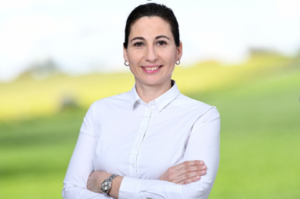Syngenta Employs Exclusive AI Platform to Accelerate R&D Pipeline
The benefits of machine learning are beginning to manifest in agriculture, and applications in R&D could have more immediate impact than comparatively simple image recognition being deployed in fields around the world. Syngenta announced Feb. 3 that it will collaborate with artificial intelligence software company Insilico Medicine to find, isolate, and synthesize new molecules while accelerating the early-development timeline a targeted 20%.
The partnership addresses the relative dearth of new AIs being commercialized in recent years, a dynamic that is putting pressure on farmers to find agronomic solutions to pest pressures, compounded by heightened regulatory scrutiny and increasingly restrictive MRLs on legacy chemistries.

Camilla Corsi, Syngenta
“The challenge of innovation has been increasing during the past few years,” says Camilla Corsi, Head of Crop Protection Research at Syngenta, in an exclusive interview with AgriBusiness Global. “There are fewer chemicals hitting the market, and we are reviewing the way that we innovate on a regular basis to make sure that we have a better chance to deliver products into the market in the future. So we have done a lot to change our platform so that we can deliver new data at a very early stage to understand, for example, selectivity toward beneficials, crops, costs, and overall sustainability of molecules in the long-term.”
The multi-year partnership is exclusive, meaning Insilico will not work with other plant protection companies. The arrangement allows the companies to share data more freely as they refine an algorithmic model catered to crop protection.
This sharing and ingestion of data points is what makes the software more able to glean insights about biological targets and the subsequent development and synthesis of new chemistries to affect those targets.
“The reason why it is exclusive is because we can create a certain amount of intimacy,” Insilico Medicine CEO Alex Zhavoronkov told AgriBusiness Global. “There is data flow from us and Syngenta so we can be a little more open about what we are doing and what they do, and we can train the model together. In order for us to get to the level of intimacy where the data can flow back and forth, we are working as a team and consider us a machine learning extension of the organization, and we feel great about that.”
In pharmaceutical development and design, the areas for which Insilico was founded, AI software processes voluminous amounts of information from peer-review journals, academic research, professional studies, and other data points to synthesize solutions to targeted disease states. This fuels the early-stage identification of predominately protein structures that influence disease.
The volume of information that is able to be analyzed by the software exceeds what humans can distill and apply to a biological circumstance. The same functionality will be applied to developing the next generation of crop protection products by feeding targeted research data into the Insilico platform so it can find new solutions to pest threats. Then, the software has the ability to invent new chemistries for specific targets.
“The algorithm optimizes in parallel many different criteria,” Corsi says. “Today we generate data and have criterial selection, but we cannot do multiple optimizations like AI, which can really excel in accelerating features of the active ingredient. So the major change is the quantity of data that you can analyze at the same time, and the diversity of output that today cannot be reached in the standard way of innovation.”
Once the platform shifts to chemical design, it can enhance the molecule development process by considering non-target toxicity and environmental impact in addition to efficacy. These “multiple optimizations” that occur will streamline development and work in tandem with existing screening and required field trials, creating a more efficient and cost-effective process that is less likely to fail in the late stages of development.
“We are expecting an impact on the early steps, specifically the ability to identify different molecules in a shorter time,” Corsi says. “We hope we will realize a 20% savings in terms of time in the research phase, which is currently 5-7 years, and the ability to shortcut multiple designs, synthesis, test, and analyze, as well as the ability to identify a smaller set of chemicals that create a greater chance for us to identify the preferred molecule … The diversity of registering molecules would make a huge difference in the types of innovation that we could bring our customers.”
The streamlined process of identifying and creating those preferred molecules could give Syngenta the ability to respond to endemic pests in specific markets, which has been cost prohibitive in the past. Additionally, AI can teach us to synthesize molecules that were once thought impossible to create because it can invent new pathways for origination. This higher-level function is the basis of an AI’s imagination, which “can go beyond human imagination with chemistry,” Zhavoronkov says. “So we are going to take this inspiration from pharma that was extremely rigorously validated and apply it to agriculture.”
Corsi says Syngenta is on pace to release two new AIs per year in the short term, a goal set a few years ago that the company is on pace to achieve. Without any current case studies in pesticide development, it’s difficult to pinpoint when the company’s pipeline will reap the rewards of AI exploration, but the potential will test the imagination of both scientists and machines and advance the development of human-AI integration for agriculture and other industries in the nascent deployment of technologies that will shape the future.
“This goes beyond the human imagination when we are developing innovation for tomorrow with molecules that we think might not be able to be synthesized, or might not be affordable, or might not have the right profile,” she says. “So it’s really going a step beyond what we are doing now to identify molecules that we couldn’t identify or imagine. Growers need to be patient for now, but we’re working to speed up innovation.”






